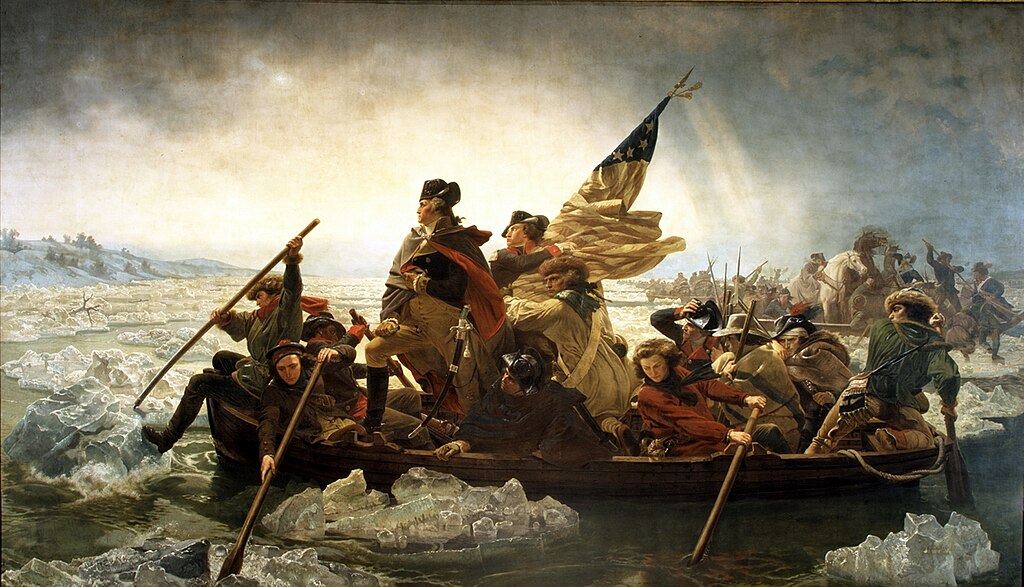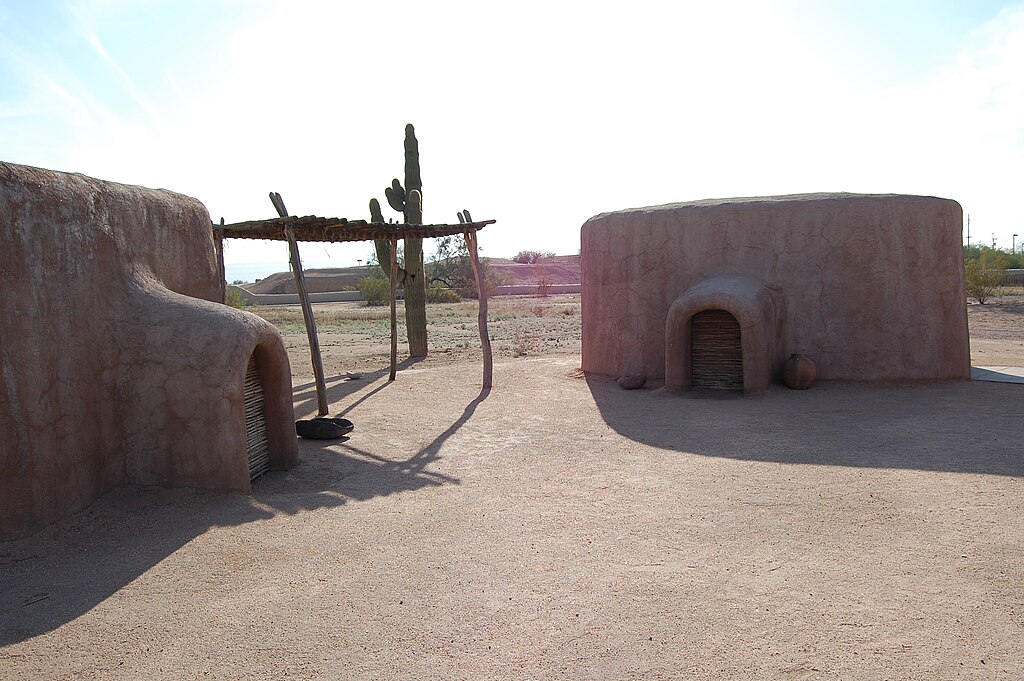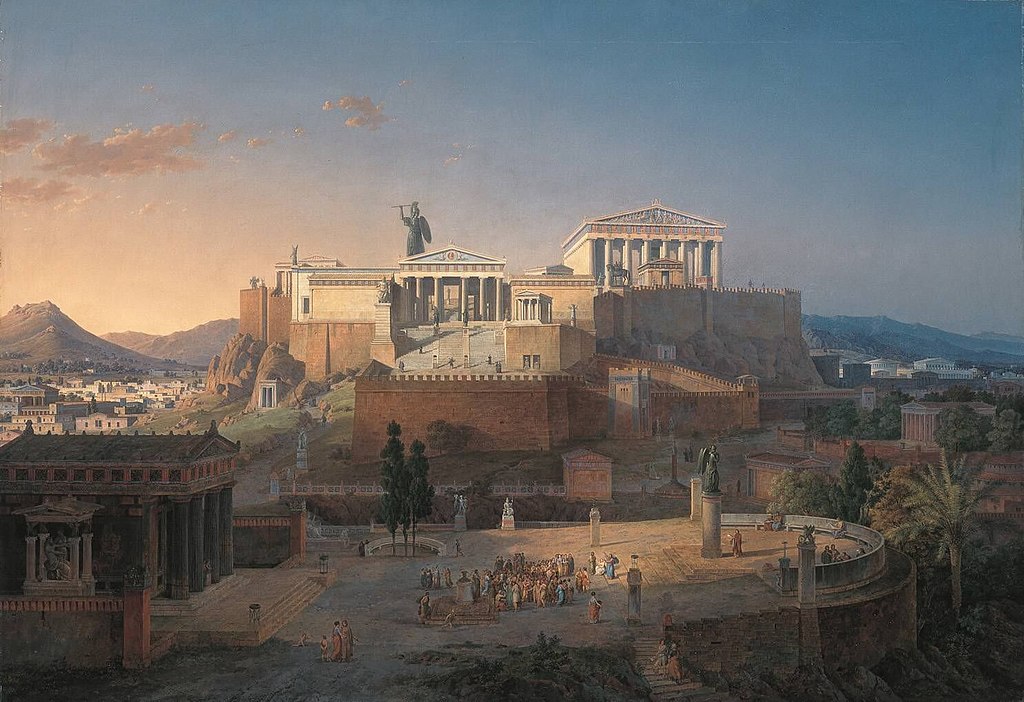
History Paintings are defined by their subject matter and usually depict a moment in a narrative story.
Before the 19th century, the most common subjects for history paintings included religious, mythological, and allegorical themes, representing the broadest view of history painting.
From the 19th-century, the term has been used in a narrower sense, to refer to the depiction of a “narrative” from history.
A Virtual Tour of History Paintings
- “Washington Crossing the Delaware” by Emanuel Leutze
- “The Family of Darius before Alexander” by Paolo Veronese
- “Las Meninas” or “The Ladies-in-Waiting” by Diego Velázquez
- “The Third of May 1808″ by Francisco Goya
- The Second of May 1808 – The Charge of the Mamelukes by Francisco de Goya
- “The Fighting Temeraire” by Joseph Mallord William Turner
- “Westward the Course of Empire Takes Its Way” by Emanuel Leutze
- “The Capture of the Hessians at Trenton, December 26, 1776″ by John Trumbull
- “The March to Valley Forge” by William B. T. Trego
- “The Massacre at Chios” by Eugène Delacroix
- “The Execution of Lady Jane Grey” by Paul Delaroche
- “Cromwell in Battle of Naseby” by Charles Landseer
- “The Surrender of Breda” by Diego Velázquez
- “Hannibal and his Army Crossing the Alps” by J. M. W. Turner
- “The Death of Marat” by Gioacchino Giuseppe Serangeli after Jacques-Louis David
- “Oath of the Horatii” by Jacques-Louis David
- “The Coronation of Napoleon” by Jacques-Louis David
- “The Burning of the Houses of Lords and Commons by J. M. W. Turner
- “The Burning of the Houses of Parliament” by J. M. W. Turner
- “The Triumph of Cleopatra” by William Etty
- “Dempsey and Firpo” by George Bellows
- Floreat Etona! by Elizabeth Thompson
- Scotland Forever! by Elizabeth Thompson
- “The Last Day of Pompeii” by Karl Bryullov
- Leonidas at Thermopylae by Jacques-Louis David
- The Election Series by George Caleb Bingham
- “The Defeat of the Floating Batteries at Gibraltar” by John Singleton Copley
- “Watson and the Shark” by John Singleton Copley
- “The Death of Major Peirson, 6 January 1781″ by John Singleton Copley
- “Frederick the Great Playing the Flute at Sanssouci” by Adolph Menzel
- “The Anatomy Lesson of Dr. Nicolaes Tulp” by Rembrandt
- “Entry of Alexander into Babylon” by Charles Le Brun
- “Pollice Verso” by Jean-Léon Gérôme
- “The Battle of Anghiari” by Peter Paul Rubens – Copy of Leonardo da Vinci’s Lost Painting
- “The Death of General Warren at the Battle of Bunker’s Hill, June 17, 1775” by John Trumbull
- “Declaration of Independence” by John Trumbull
- “The Death of General Mercer at the Battle of Princeton, January 3, 1777″ by John Trumbull
- “Benjamin Franklin Drawing Electricity from the Sky” by Benjamin West
- “American Commissioners of the Preliminary Peace Agreement with Great Britain” by Benjamin West
- “The Kearsarge at Boulogne” by Édouard Manet
- “The Battle of the Kearsarge and the Alabama” by Édouard Manet
History paintings almost always contain some figures and usually showing action or drama that is central to a narrative.
History paintings were traditionally regarded as the highest form of Western art, occupying the most prestigious place in the hierarchy of genres.
Historic Paintings were considered equal to the epics in literature because it was a visual form of history, with the potential to stir emotions in the audience.
Scenes from ancient history were popular in the early Renaissance, and again in the Baroque and Rococo periods, and peaked with the rise of Neoclassicism.
In the 20th century, the term referred expressly to paintings of scenes from secular history, rather than those from religious narratives, literature, or mythology.
This list of History Paintings is derived from the paintings that are the most searched for on this website. Religious narratives, literature, or mythology paintings are listed separately below.
History Paintings
“Washington Crossing the Delaware” by Emanuel Leutze
“Washington Crossing the Delaware” by Emanuel Leutze commemorates General George Washington’s crossing of the Delaware River with the Continental Army on the night of Christmas 1776, during the American Revolutionary War.
The composition shows General Washington highlighted by the white clouds in the background, as his face is lit by the upcoming Sun.
The distant boats and dramatic sky all provide heroic depth to the painting.
“The Family of Darius before Alexander” by Paolo Veronese
“The Family of Darius before Alexander” by Paolo Veronese depicts Alexander the Great with the family of the Persian King he had defeated in battle.
Other artists had rarely depicted the story in this painting before Veronese. The story is centered on the events in 333 BC when Alexander defeated King Darius III’s army.
Darius panicked and abandoned his army and family to narrowly escaped capture. Alexander’s forces quickly captured his wife, mother, and his daughters, who were left behind by Darius.
“Las Meninas” or “The Ladies-in-Waiting” by Diego Velázquez
“Las Meninas” or “The Ladies-in-Waiting” by Diego Velázquez is a complex and mysterious composition which, when studied, creates an ambiguous relationship between the audience and the various subjects in this painting.
The complex arrangement of Las Meninas has made this painting one of the most analyzed masterpieces in Western art.
“The Third of May 1808″ by Francisco Goya
“The Third of May 1808” by Francisco Goya depicts the early hours of the morning after the uprising in May 1808 by the people of Madrid against the occupation of the city by French troops.
Goya portrays the French as a rigidly firing squad, and the citizens are represented as a disorganized group of captives held at gunpoint. Executioners and victims face each other in a confined space.
The Spanish uprising had provoked harsh repression by the French forces.
The Second of May 1808 – The Charge of the Mamelukes by Francisco de Goya
“The Second of May 1808” by Francisco de Goya, also known as The Charge of the Mamelukes, depicts one of the many rebellions against the French occupation of Spain that sparked the Peninsular War.
The scene is set in a public square in Madrid during the Second of May 1808 represents the beginning of the uprising. The Mamelukes of the French Imperial Guard were ordered to charge the rioting Spanish citizens by the French.
The crowd saw the Mamelukes as Moors, which provoked an angry response. Instead of dispersing, the crowd turned on the charging Mamelukes, resulting in a ferocious fight. Goya chose not to paint the focal point to emphasize the chaos of the drama.
“The Fighting Temeraire” by Joseph Mallord William Turner
The Fighting Temeraire is an oil painting by the English artist Joseph Mallord William Turner. The painting depicts the HMS Temeraire, a battle-aged and decommissioned gunship being towed by a paddle-wheel steam tug to her last berth in 1838 to be broken up for scrap.
This painting was an immediate success for Turner, with the critics and the public, but he never sold it.
Turner refused offers to sell the painting, having determined to leave it to the nation. He called this work his “darling.”
“Westward the Course of Empire Takes Its Way” by Emanuel Leutze
“Westward the Course of Empire Takes Its Way” by Emanuel Leutze is a painted study of a massive painted mural currently displayed behind the western staircase of the House of Representatives chamber in the United States Capitol Building.
The picture depicts a group of pioneers on their journey westward as they catch their first glimpse of the “promised land” of California.
“The Capture of the Hessians at Trenton, December 26, 1776″ by John Trumbull
“The Capture of the Hessians at Trenton, December 26, 1776” by John Trumbull depicts the capture of the Hessian soldiers at the Battle of Trenton on the morning of December 26, 1776, during the American Revolutionary War.
At the center is General George Washington aiding the mortally wounded Hessian Colonel. Trumbull’s intended was to show the compassion of General George Washington in this painting.
“The March to Valley Forge” by William B. T. Trego
“The March to Valley Forge” by William B. T. Trego depicts George Washington and the veterans of his army limping into their winter encampment in Valley Forge.
Valley Forge was the military camp 18 miles (29 km) northwest of Philadelphia, where the American Continental Army spent the winter of 1777–78.
“The Massacre at Chios” by Eugène Delacroix
“The Massacre at Chios” by Eugène Delacroix is a massive painting showing the horror and destruction visited on the Island of Chios.
A display of suffering, military might, ornate costumes, terror, and death in a scene of widespread desolation.
There is no heroic figure to counterbalance the massacre and the hopelessness of the victims, and there is no suggestion of hope among the ruin and despair.
“The Execution of Lady Jane Grey” by Paul Delaroche
“The Execution of Lady Jane Grey” by Paul Delaroche portrays the moments preceding the death of Lady Jane Grey, who was proclaimed Queen of England in 1553, only to be deposed nine days later and to be executed.
Jane is sometimes called the “Nine Days’ Queen” due to the brevity of her reign.
“Cromwell in Battle of Naseby” by Charles Landseer
“Cromwell in Battle of Naseby” by Charles Landseer depicts Cromwell reading a letter from the King’s private papers that were found in Charles’s Cabinet, after the Battle of Naseby.
In this decisive battle, King Charles I lost the bulk of his veteran infantry and officers, all of his artillery and stores, his baggage, and many arms.
Captured in the baggage train were the King’s private papers, revealing to the fullest extent his attempts to draw Catholics and foreign mercenaries into the war.
“The Battle of Anghiari” by Peter Paul Rubens – Copy of Leonardo da Vinci’s Lost Painting
“The Battle of Anghiari” by Peter Paul Rubens, is a copy of a lost Leonardo da Vinci fresco, it depicts four Knights engaged in a battle for possession of a standard, at the Battle of Anghiari in 1440.
Rubens successfully portrayed the fury, the intense emotions, and the sense of power that were present in Da Vinci’s original painting.
Leonardo da Vinci made many preparatory studies that still exist. Da Vinci’s composition of the central section is known through this drawing copy by Peter Paul Rubens.
Rubens’s copy, dating from 1603, was based on an engraving of 1553 by Lorenzo Zacchia, which was taken from the painting itself. Museum: Louvre Museum
“The Death of General Warren at the Battle of Bunker’s Hill, June 17, 1775” by John Trumbull
“The Death of General Warren at the Battle of Bunker’s Hill, June 17, 1775” by John Trumbull is the title of several oil paintings completed by the artist depicting an early conflict during the American Revolutionary War. The pictures are iconic images of the American Revolution.
The central focus of the painting is Warren’s body, dressed in white, and a British major, dressed in a scarlet uniform holding a sword in his left hand and over his shoulder.
John Small, the British major, is shown preventing a fellow British soldier from bayoneting Warren. Trumbull wanted to express the poignancy in the conflict of men who knew each other and had earlier served together.
“Declaration of Independence” by John Trumbull
“Declaration of Independence” by John Trumbull depicts the presentation of the draft of the Declaration of Independence to Congress.
The painting is often incorrectly described as the signing of the Declaration of Independence. The picture actually shows the five-person drafting committee presenting their draft of the Declaration to Congress.
Thomas Jefferson and Benjamin Franklin are the two in front, and John Adams is to the right of Jefferson.
In the painting, Thomas Jefferson standing with the red vest, appears to be stepping on John Adams’ foot. Many thought this symbolized their relationship as political enemies.
“The Death of General Mercer at the Battle of Princeton, January 3, 1777″ by John Trumbull
“The Death of General Mercer at the Battle of Princeton, January 3, 1777” by John Trumbull depicts the death of the American General Hugh Mercer during the American Revolutionary War.
The composition illustrates several different events during the battle as if they co-occurred at one point in time. The Battle of Princeton was fought near Princeton, New Jersey, which ended in a small victory for the Colonials.
In the center is the American General Hugh Mercer, as he leans on his dying horse beneath him, as he lies wounded.
Mercer was commanding the leading division of the Continental Army when attacked by the British near Princeton, New Jersey. Mercer’s horse was killed, and two grenadiers attacked him. The British were in control of the battle at this moment.
Quotes about History by famous people express their truth based on their experience and feelings.
Quotes about History are famous because most people can relate to them in some way and on some level.
~~~
“Our greatest glory is not in never falling, but in rising every time, we fall.”
– Confucius
~~~
“Those who don’t know history are destined to repeat it.”
– Edmund Burke
~~~
“Study history, study history. In history lies all the secrets of statecraft.”
– Winston Churchill
~~~
“History is the version of past events that people have decided to agree upon.”
– Napoleon Bonaparte
~~~
“History is a cyclic poem written by time upon the memories of man.”
– Percy Bysshe Shelley
~~~
“History doesn’t repeat itself, but it does rhyme.”
– Mark Twain
~~~
“Not to know what has been transacted in former times is to be always a child. If no use is made of the labors of past ages, the world must always remain in the infancy of knowledge.”
– Marcus Tulius Cicero
~~~
“History is not a burden on the memory but an illumination of the soul.”
– Lord Acton
~~~
“History repeats itself, first as tragedy, second as farce.”
– Karl Marx
~~~
“Anybody can make history. Only a great man can write it.”
– Oscar Wilde
~~~
“God cannot alter the past, but historians can.”
– Samuel Butler
~~~
“A page of history is worth a pound of logic.”
– Oliver Wendell Holmes
~~~
“History will be kind to me for I intend to write it.”
– Winston Churchill
~~~
“Human history becomes more and more a race between education and catastrophe.”
– H. G. Wells
~~~
“We spend a great deal of time studying history, which, let’s face it, is mostly the history of stupidity.”
– Stephen Hawking
~~~
“We learn from history that we learn nothing from history.”
– George Bernard Shaw
~~~
“We can learn from history, but we can also deceive ourselves when we selectively take evidence from the past to justify what we have already made up our minds to do.”
– Margaret MacMillan
~~~
A Virtual Tour of Art
- Christian Art
- Buddhist Art
- Mythological Paintings
- History Paintings
- Popular Portraits
- Egyptian Art
- Mesopotamian Art
- Islamic Art
- Specialist Museums
Introduction to History Painting
~~~
“We hunger to understand, so we invent myths about how we imagine the world is constructed – and they are, of course, based upon what we know.”
– Carl Sagan
~~~
Photo Credit: By Giovan Battista Gaulli – Beauvais, Musée départemental de l’Oise ([1] – Olio su tela, cm. 149 x 222) [Public domain], via Wikimedia Commons
Top Posts & Pages








 Sponsor your Favorite Page
Sponsor your Favorite Page SEARCH Search for: Search Follow UsJoin – The JOM Membership Program
Become a Patron!
Sponsor a Masterpiece with YOUR NAME CHOICE for $5
Share this:
- Tweet
